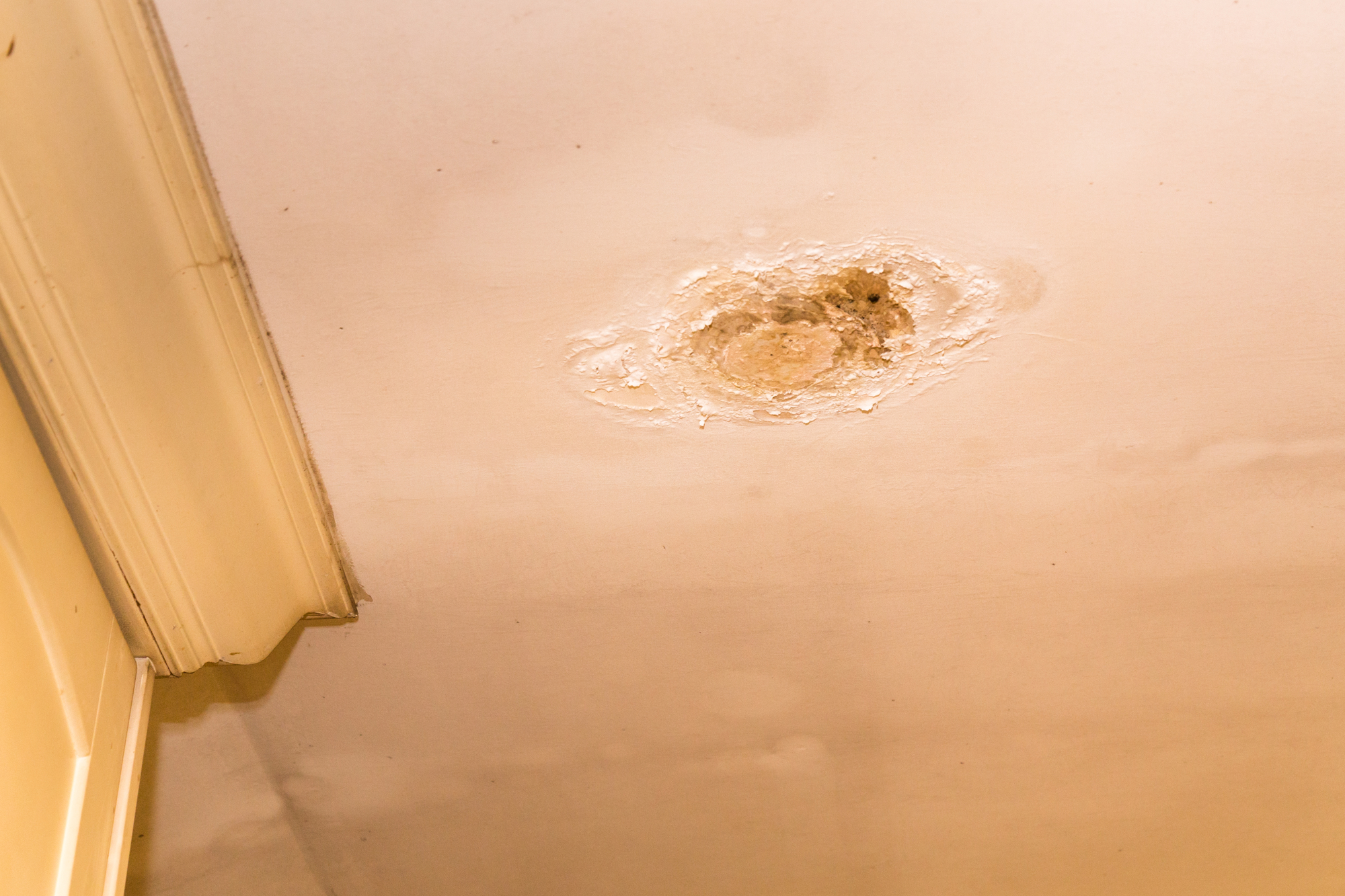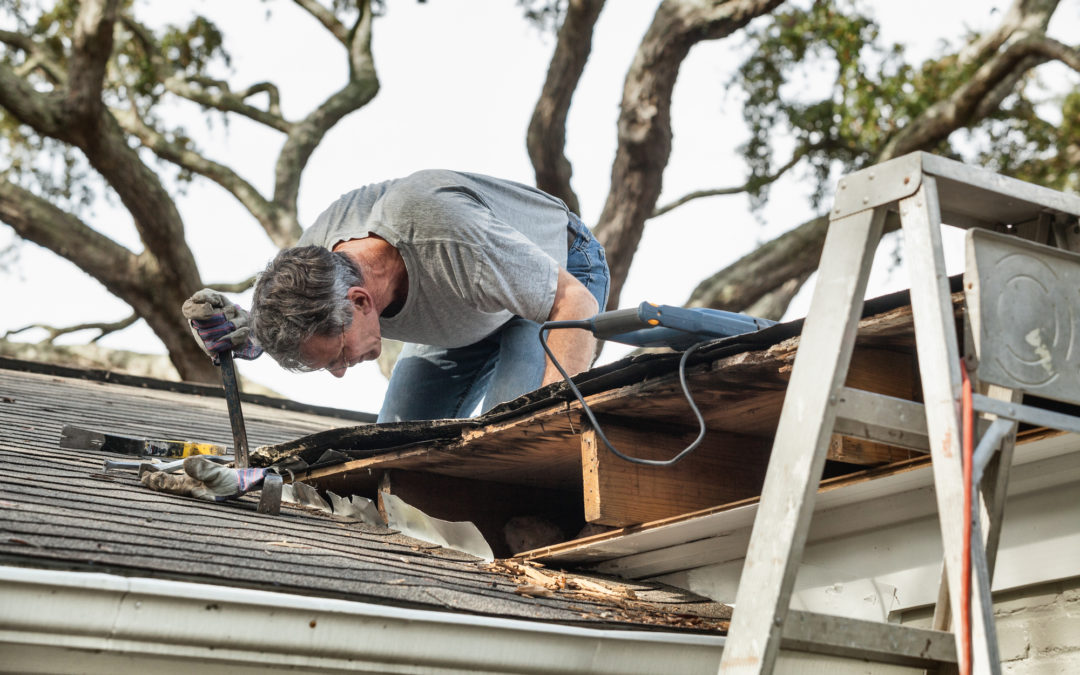If you notice your roof leaking you need to contact a roofing professional immediately. Roof leaks can lead to irreparable damage and expensive repairs. While you wait for professional repairs you can prevent the spread of damage by patching the leak or placing a bucket to catch any water dripping and protect your floors.
HOW CAN I TELL IF I HAVE A ROOF LEAK?
The most obvious signs that your roof is leaking are a water stain on your ceiling or a drip of water coming from your ceiling. If you notice the signs of a roof leak, it’s time to act – fast. A roof won’t repair itself and what appears to be a minor leak can quickly become a major problem causing permanent damage to your home.
Signs of a Roof Leak
There are some signs of roof damage that are visible from the exterior of your house. Exterior signs of potential leaks may help you catch the damage before a leak starts. These signs include:
- Water spots under the roofline
- Plant growth on the exterior walls
- Debris in your downspouts
- Missing shingles
Interior signs of leaking tend to be more obvious. Interior signs for your roof leaking include:
- Water stain on ceiling
- Mold or moisture on walls or ceiling
- Dripping from ceiling, consistent or irregular
WHAT ARE COMMON CAUSES OF A ROOF LEAK?

Cracks can be caused by weather or even by people walking on the roof too much. Any number of things can cause a roof to leak. The most common causes of roof leaks are:
- Cracking in the shingles
- Flashing
- Vent booting
- Water entering your chimney
- Build-up of ice on your roof
- Improperly installed skylights
- Attic moisture
- Clogged gutters
HOW DO I FIND THE LEAK?

The location of a water spot on your ceiling or of a drip isn’t always the location of the leak. Water can drip down the roof and rafters to a lower point before dripping onto the ceiling below. The best time to find a roof leak is when the water is actively dripping so that you can see where the water is coming in.
While it’s raining, take a flashlight up into the attic since the light will reflect on the water. If it’s not raining, you can use a garden hose to get the roof completely wet. If there is a water spot on the ceiling below, you can follow the water drop from this location to its source.
You can also look for active drips coming in from the roof. Once you’ve pinpointed the leak’s location, measure the distance from the leak to the peak of the roof and to a gable end. You can use those measurements to locate the location of the leak on the outside of the roof once the roof has dried.
For example, if you know that the leak is five inches from the peak and two feet from the gable end of the house within the attic, when you go out onto your roof, you can measure down five inches from the peak of the roof and two feet in from that same gable end to pinpoint the exact location of the leak.
HOW CAN I IDENTIFY THE CAUSE OF THE LEAK?
Once you’ve identified the location of the leak, the cause is usually visible at the leak location. For example, cracking or a hole may be visible. If there isn’t an obvious cause of the leak at the location you measured, check further up the roof. Sometimes water can leak behind the shingles before getting into the attic.
DO I NEED TO FIND THE SOURCE OF THE LEAK?
In order to repair the leak, you’ll need to find out exactly where the water is coming into the house. If the location of the leak isn’t pinpointed, the entire roof may need to be replaced to fix the leak.
If you can’t find the source of the leak on your own, a roofing professional can inspect your roof before repairs to identify the cause.
Need help with a roof leak?
CAN I FIX THE LEAK MYSELF OR WILL I NEED PROFESSIONAL HELP?

Some roof leaks can be fixed by you, the homeowner. But it depends on the type of roof, your DIY skills, and whether or not you’re afraid of heights.
Professional help may be required for roofs with greater damage or on steeper roofs that are unsafe to walk on. Fixing a leak yourself is only advisable if your skills are very good. Amateur repairs that are done improperly may cause more damage over time.
Even if you decide to risk doing a repair on your own, you should have a roofing professional assess the state of the roof after your repair to ensure no further damage was done and the original source of the leak was completely resolved.
WHAT CAN I DO TO STOP THE LEAK?
The leak may only be completely stopped when the roof is repaired, but there are some temporary measures that you can take to minimize the damage.
If you’re handy and the rain has stopped, you can put a temporary patch on the leak.
If you’re not handy, you can still try to contain the leak and prevent it from causing too much damage within your house using a bucket or trash can.
HOW DO I CONTAIN THE WATER?
Place a bucket or trash can underneath the drip, moving any furniture or possessions out of the way. Then, take a screwdriver and puncture a hole in the ceiling in the center of the bulge. Poking a hole in your ceiling may seem counterintuitive, but it will help relieve the pressure on your ceiling and prevent it from collapsing.
HOW LONG CAN I WAIT TO CONTACT A PROFESSIONAL?

The longer a leak goes unrepaired, the more damage it can cause. Therefore, it’s essential to address the problem as quickly as possible.
Keep in mind: Contractors cannot come out to repair your roof while it is raining, so make sure you take precautions to contain the leak as best you can then call a contractor to make an appointment for when the rain stops.
Even if the leak stops you should still contact your roofing professional. Some leaks with appear to have stopped and ‘fixed themselves’ but will pop up again later. This then leaves your roof at risk to steady, long-term water damage.
WHAT SHOULD I LOOK FOR IN A CONTRACTOR?
Before you call a contractor out to repair your roof, you should first check for these things:
- Check to make sure the contractor has their own insurance.
- Don’t hire someone who just happened to be “in the area” after a big storm.
- Hire a local contractor that has a good reputation in your community.
- Make sure they communicate with you and are willing to put contract details into writing.
Read more about what to look for in a roofing contractor.
Ready for a new roof?
WHAT SHOULD I DO WHILE I’M WAITING FOR HELP?
While you are waiting for a contractor to repair your roof, you can contain the leak within the house. In addition, you can put up an emergency tarp to prevent more water from getting inside your house while you are waiting for the professionals to arrive.
HOW MUCH DOES IT COST TO FIX A ROOF LEAK?
The cost of repairing a roof leak varies and depends on the extent of the damage. Most homeowners can look at paying an average of $650 for the repair, but the cost can range from $300 to $1,000. If the leak is very small and if the repair doesn’t require many materials, the repair could cost as little as $150. If you’d like an estimate of costs, give us a call at (407) 732-7262 and we’d be happy to help or answer any questions.
IS THE LEAK REPAIR COVERED BY MY INSURANCE?

Whether or not the leak repair is covered by your insurance depends on what caused the leak. If the damage was caused by a storm, your insurance, provided it doesn’t have a wind or hail exclusion, may cover the cost of the repair.
However, if it’s caused by wear and tear then the repair is considered part of routine maintenance.. In this case it will most likely not be covered. It’s recommended to check your homeowner’s insurance policy so you are familiar with what will and will not be covered so you can take any necessary precautions.
If you’re wanting to replace or repair your roof but your insurance company isn’t giving you enough money to cover it, you have the option of signing an AOB. Only sign an AOB with a roofer you trust. Signing an AOB will allow roofers, like us, to use our industry experience to negotiate on your behalf. We’ve recovered thousands of extra dollars from insurance companies for hundreds of our clients. Are you being ‘short-paid’ or underpaid by your insurance company? Click here for more information on whether you should sign an AOB.
WILL INSURANCE COVER DAMAGED BELONGINGS?
If your insurance provides coverage for personal property and the roof repair was covered by your insurance, then your belongings should also be covered. However, your belongings may not be covered if the leak was caused by wear and tear rather than a covered event.
WILL I NEED A NEW ROOF?
If your roof is relatively new and the damage was caused in an isolated area, a leak repair may be sufficient. However, if the damage is widespread or if it was caused by general wear and tear, it might be time to get a new roof. If there are cracks in the flashing, the roof is sagging, or the shingles are curling or cracked, those are signs that your roof may need to be replaced.
When you have your roof replaced be sure to find a reputable roofing contractor by doing research prior to signing any contracts.
HOW CAN I PREVENT FUTURE LEAKS?
The best way to prevent future leaks is to make sure that you regularly inspect and maintain your roof. Regularly check the most common leak locations, such as chimneys, skylights, flashing, gutters, and vents. Also regularly check your attic for mold and damp spots. Then, if you see a problem, you can get it repaired before it actually turns into a leak.


 “Francisco is an amazing contractor and his company and crews are just as good. Had to opportunity to experience his work at home in Windermere and the office building in Altamonte Springs. Both flooring and tile work were fantastic. Helped with selection and got job done quickly.”
“Francisco is an amazing contractor and his company and crews are just as good. Had to opportunity to experience his work at home in Windermere and the office building in Altamonte Springs. Both flooring and tile work were fantastic. Helped with selection and got job done quickly.”